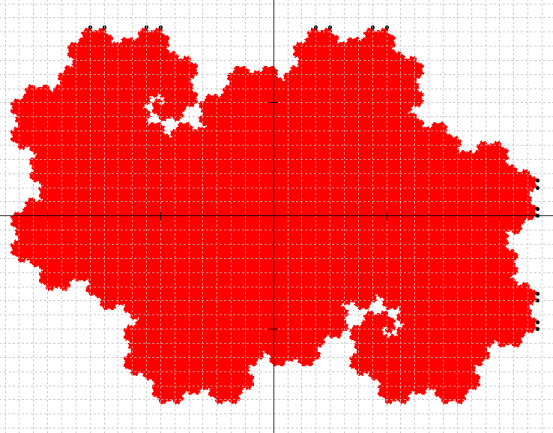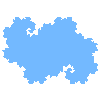


Because of the symmetry of the Heighway Z2 dragon we can focus on the growth in just the right and top parts of the fractal as we iterate the IFS.
 |
Start the construction of the Heighway Z2 dragon with symmetric segment along the x-axis from −1 to 1. The grid size is 1/4 x 1/4. |
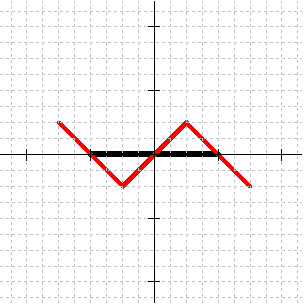 |
The first iteration produces the figure to the left that has expanded by 1/2 in both the horizontal and vertical directions. |
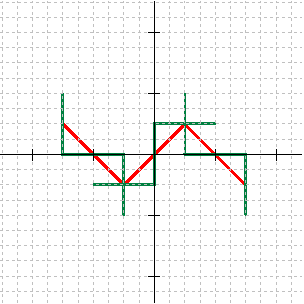 |
The second iteration produces horizontal and vertical line segments. The top has expanded upward by another 1/2, but the right remains the same. |
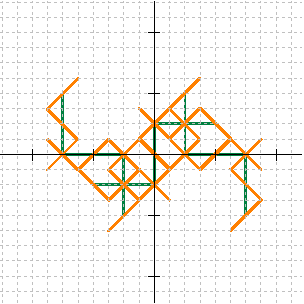 |
The third iteration again produces diagonal line segments. The top and the right have each expanded by 1/4. |
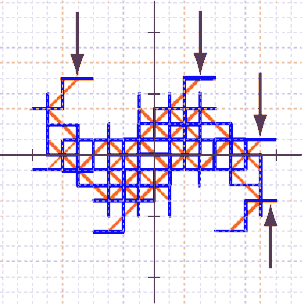 |
The fourth iteration again produces horizontal and vertical line segments. The right has expanded by 1/4 but the top has not changed. Notice the four line segments at the top and right indicated by the arrows. These are horizontal segments of length 1/2, mimicking the initial line segment of length 2 but reduced in size by a factor of 1/4. |
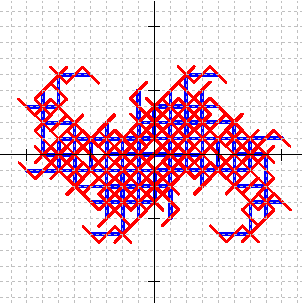 |
At the fifth iteration both the top and right sides have expanded by 1/8. Place your mouse over the image to the left for a view that shows how the iteration 1 figure |
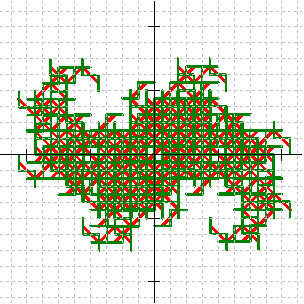
|
At the sixth iteration the top has expanded by another 1/8 but the right stays the same. Place your mouse over the image to the left for a view that shows how the iteration 2 figure |
And now for the important observation. The line segments at the top and the right after the fifth iteration have the same shape as back in iteration 1, and the line segments at the top and the right after the sixth iteration have the same shape as back in iteration 2, but each reduced by a factor of 1/4. The pattern of iterations 1, 2, 3, and 4 will repeat itself over and over. In particular, the amount that the top and right sides expand at each iteration repeats in cycles of 4 but changes by a factor of 1/4 for each cycle.
The growth in the size of the Heighway Z2 dragon is therefore given by the following geometric series.
right |
\[\begin{aligned} &\left( \frac{1}{2}+0+\frac{1}{4}+\frac{1}{4} \right) + \left(\frac{1}{8}+0+\frac{1}{16}+\frac{1}{16} \right) + \left( \frac{1}{32}+0+\frac{1}{64}+\frac{1}{64} \right) + \ldots \\ \\ &= \frac{1}{2} + \frac{1}{2} + \frac{1}{8} + \frac{1}{8} + \frac{1}{32} + \frac{1}{32} + \ldots \\ \\ &= 1 + \frac{1}{4} + \frac{1}{16} + \ldots = \frac{1}{1-\frac{1}{4}} = \frac{4}{3} \end{aligned}\] |
top |
\[\begin{aligned} &\left( \frac{1}{2}+\frac{1}{2}+\frac{1}{4} +0 \right) +\left(\frac{1}{8}+\frac{1}{8}+\frac{1}{16} +0 \right) + \left( \frac{1}{32}+\frac{1}{32}+\frac{1}{64} +0\right) + \ldots \\ \\ &= 1+\frac{1}{4} + \frac{1}{4} + \frac{1}{16} + \frac{1}{16} + \frac{1}{64} + \frac{1}{64} + \ldots \\ \\ &= 1 + \frac{1}{2} + \frac{1}{8} + \frac{1}{32}+\ldots =1+ \frac{\frac{1}{2}}{1-\frac{1}{4}} = 1+\frac{2}{3} =\frac{5}{3}\end{aligned}\] |
Because the initial line segment went from x = −1 to x = 1, the total width of the dragon extends from x = −7/3 to x = 7/3.
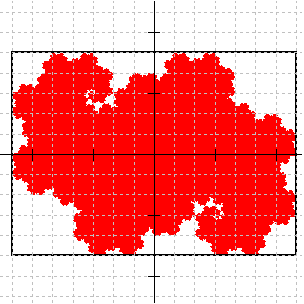
(grid 1/3 x 1/3)
The Z2 dragon appears to touch the bounding rectangle at several places along the four sides of the rectangle. This actually happens at an infinite number of points along each of the four sides of the rectangle. These points are of the following form [Details] for n ≥ 0, where b0 = 0 and bn, n ≥ 1, represents a non-negative integer whose base-4 representation has n digits consisting of only 0 and 1.
Right Edge: \[\left( \frac{7}{3}, \frac{b_n}{4^n}\right) \; \text{ and } \; \left( \frac{7}{3}, -1+\frac{b_n}{4^n}\right)\] Top Edge: \[ \left( 1-\frac{b_n}{2 \cdot 4^{n-1}}, \frac{5}{3} \right) \; \text{ and } \; \left( -1-\frac{b_n}{2 \cdot 4^{n-1}}, \frac{5}{3} \right) \] Left Edge: \[ \left( -\frac{7}{3}, 1-\frac{b_n}{4^n} \right) \; \text{ and } \; \left( -\frac{7}{3}, -\frac{b_n}{4^n} \right) \] Bottom Edge: \[ \left( -1+\frac{b_n}{2 \cdot 4^{n-1}}, -\frac{5}{3} \right) \; \text{ and } \; \left( 1+\frac{b_n}{2 \cdot 4^{n-1}}, -\frac{5}{3} \right) \]
For example, when n = 2, the possible values for b2 are (00)4 = 0, (01)4 = 1, (10)4 = 4, and (11)4 = 5. Eight of the boundary points of the Z2 dragon that touch the right side of the bounding rectangle would be (7/3, 0), (7/3, 1/16), (7/3, 4/16), (7/3, 5/16), (7/3, −11/16), (7/3, −12/16), (7/3, −15/16) and (7/3, −1). Along the top edge we have the points (1, 5/3), (7/8, 5/3), (4/8, 5/3), (3/8, 5/3), (−1, 5/3), (−9/8, 5/3), (−12/8, 5/3), and (−13/8, 5/3). These points are shown by the black dots in the figure below.
